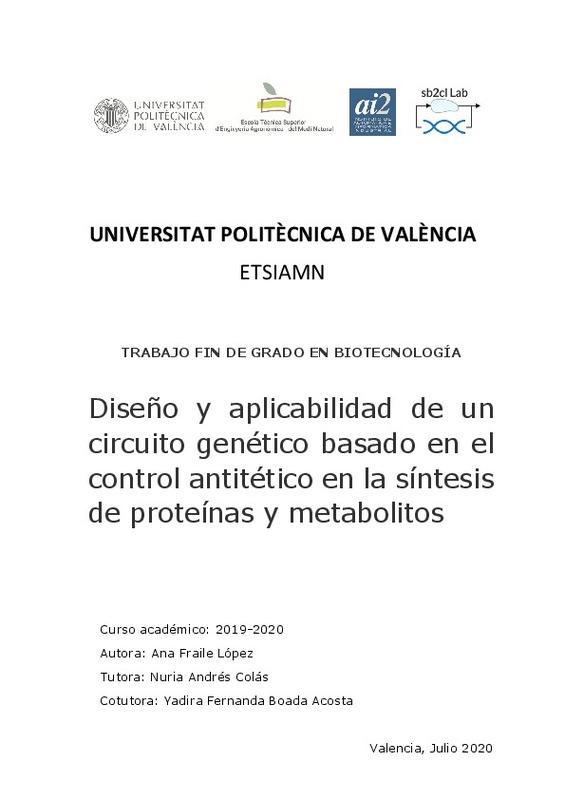|
Resumen:
|
[ES] La biología sintética toma conceptos de ingeniería para el diseño y la construcción de circuitos genéticos con un comportamiento deseado, modificando y combinando diferentes elementos genéticos que ya existen en la ...[+]
[ES] La biología sintética toma conceptos de ingeniería para el diseño y la construcción de circuitos genéticos con un comportamiento deseado, modificando y combinando diferentes elementos genéticos que ya existen en la naturaleza. El control y la regulación de los niveles de producción de proteínas expresadas por estos circuitos genéticos, juegan un papel esencial cuando se intenta construir sistemas con comportamientos cada vez más complejos, con distintas aplicaciones en áreas como biotecnología, biomedicina, farmacéutica, ciencias biológicas, ingeniería genética, etc.
El objetivo de este trabajo es el diseño y análisis de un circuito genético llamado controlador antitético para regular la producción de una proteína de interés a nivel transcripcional. En Escherichia coli, el sistema de control se basa en la aniquilación mutua de dos proteínas: Sigma70 y Anti-Sigma70. La proteína Sigma70 es un cofactor de la RNA polimerasa, que actúa promoviendo la expresión de proteínas. La proteína Anti-Sigma70 se une a la Sigma70 con mucha fuerza, reduciendo la actividad de la RNA polimerasa, y por lo tanto la producción de ARN mensajero de la proteína de interés. En este trabajo se diseñará y analizará el controlador antitético partiendo de las reacciones bioquímicas involucradas. Estas reacciones se traducirán en un modelo matemático y se utilizarán para la realización de simulaciones computacionales, que nos proporcionarán guías de diseño para la selección de las partes biológicas del controlador en el laboratorio.
Una de las principales características del controlador antitético es su mecanismo de retroalimentación. Mecanismos de este tipo existen de forma natural en las células vivas permitiendo regular muchos comportamientos celulares. Esta cualidad puede ser aprovechada en aplicaciones de la industria biotecnológica que incluyan la producción robusta y con rechazo a perturbaciones del medio extracelular de proteínas heterólogas, enzimas, o metabolitos.
[-]
[EN] Synthetic biology takes engineering concepts to design and build gene circuits with a desired behavior, by modifying and combining different biological elements that already exist in nature. Control and regulation of ...[+]
[EN] Synthetic biology takes engineering concepts to design and build gene circuits with a desired behavior, by modifying and combining different biological elements that already exist in nature. Control and regulation of protein production levels expressed by these gene circuits play an essential role when one tries to build more complex systems. These new gene circuits have different applications in areas such as biotechnology, biomedicine, pharmaceuticals, biological sciences, genetic engineering, etc.
The aim of this work is to design and analyze a genetic circuit called antithetic controller that regulates the production of a protein of interest at the transcriptional level. In Escherichia coli, this controller is based on the mutual annihilation of two proteins: Sigma70 and Anti-Sigma70. The Sigma70 protein is a cofactor of RNA polymerase, which promotes protein expression. The Anti-Sigma70 protein binds to Sigma70 very strongly and reduces the activity of RNA polymerase. Therefore, messenger RNA production of the protein of interest is also decreased. In this work, we analized the species of the antithetic controller, the biochemical reactions involved, and its dynamic behavior inside the cell using a mathematical model. Then, computational simulations will provide us with design guidelines in the selection of the biological parts for the antithetic controller.
One of the main characteristics of the antithetic controller relies in its feedback mechanism. It has been shown that different types of feedback already exist in living cells and regulate many cellular behaviors. This quality can be exploited in several applications of the biotechnology industry that include rejection of extracellular disturbances and robust production of heterologous proteins, enzymes, or metabolites.
[-]
|




![PDF file [Pdf]](/themes/UPV/images/pdf.png)



